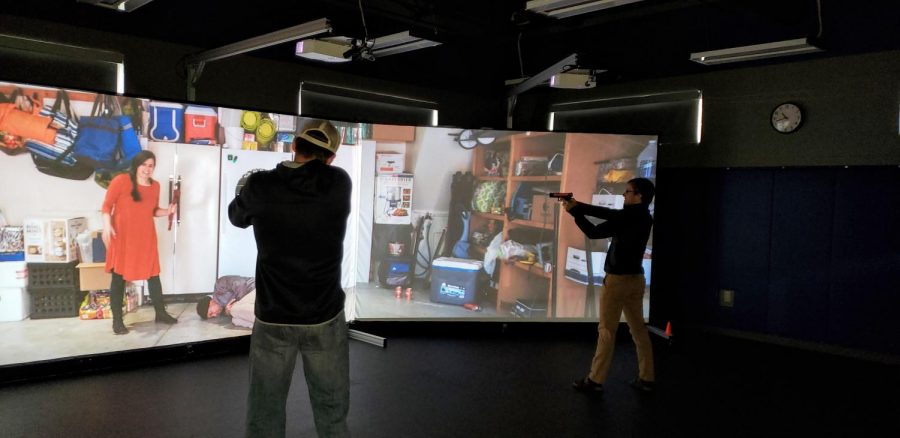Simulator provides realistic police training
A new simulator in the criminal justice department allows students to practice use-of-force.
November 8, 2018
Two officers approach a man in an underpass filled with graffiti where there have been reports of an adult male waving a gun and exhibiting disturbing behavior. The man turns around, revealing dark circles around his eyes, the Marine Corps emblem on his tank top and a handgun tucked into his waistband.
The officers begin raising their guns as he continues to yell incoherently, ignoring orders to put his hands up. Suddenly, he draws his weapon, and there’s sound of gunfire. The man drops. The three massive projection screens darken, and the simulation ends.
Criminal justice students learned how to make split-second decisions in a series of real-life simulations at the Northeast Wisconsin Technical College Public Safety Department in Green Bay on Nov. 5.
The 180-degree simulator includes a selection of more than 700 scenarios designed to train officers how to appropriately de-escalate high-stress confrontations. The equipment was used by students as part of a lecture about use-of-force in the criminal justice program’s police deviance course.
The professor of the course, Durmus Camlibel, said being exposed to real-life scenarios gives students the ability to quickly determine what type of situational force is appropriate.
“In here, maybe using a taser will not be very logical for them, or using pepper spray, because the subject has a gun in his hand and he is threatening and he wasn’t really cooperative,” Camlibel said. “Whenever he pulled his gun, students, they’re given a split second decision: ‘What do I have to do? Shoot or not shoot?’”
Camlibel said these scenarios also train students to identify more subtle red flags.
“He looks like a frantic or not-mentally-stable person, but he also has a Marine Corps T-shirt on him,” Camlibel said. “So that’s also another indicator. Maybe he knows how to use a firearm.”
Zachary Radde, a student participating in the program, said just communicating with people in the simulation could impact the course of the scenarios.
“Obviously, it is not like person-to-person interaction, but the simulated characters that we were interacting with were able to respond to our commands and change their actions based on how we were performing,” Radde said. “The instructor in control of the simulator was able to change how the person would act or react to our actions.”
Camlibel said this teaches students how to communicate appropriately in a variety of situations.
“Police presence and verbal command is important,” Camlibel said. “So in here, students first use their verbal skills.”
In another scenario, students are brought to a warehouse where a burglary has been reported. An unknown man emerges from underneath a counter, claiming to be an employee. With his hands concealed behind the counter, he repeatedly commands the simulation users to leave, then pulls out an unidentifiable object.
Camlibel said his goal is to prevent fatal mistakes from being made on the field.
“You have to wait and see what he’s going to show you,” Camlibel said. “Maybe it might be a gun, maybe a cell phone, maybe he wants to call his boss or supervisor, right? You never know, but this is also a very stressful situation for the police officer. In the media, we see ‘Police shoot and kill unarmed person.’ Why? Because when you ask them, they felt that there was a gun.”
UWO student Hunter Tank, who also participated in the simulation, said he felt it provided a fairly accurate representation of what police officers encounter in the field.
“The people conducting the simulator had hundreds of possible situations, such as active shooters, car accidents, child dispute cases and traffic stops, among many more,” Tank said. “The only thing I didn’t like about the simulation was the fact that people on the screen couldn’t really respond to what you were saying to them. I believe in some cases, I could have intervened to better control the situations if it was actually in real life, instead of being forced to fire my weapon.”
Radde said he thinks this type of equipment should be made accessible to the public.
“For the amount of backlash that cops get, it would give people an understanding of why they do what they do,” Radde said. “Sometimes force is needed, and it is unavoidable. The public, I believe, would have a better outlook on police if they saw a glimpse of what they have to deal with.”
Another participant, Dellas Vandenberg, said the simulation is valuable because it conveys what it’s like to be involved in such high-stress confrontations.
“Just like what the public does, it’s easy for us to say they should’ve done that or something else from what they did,” Vandenberg said. “But when you get put in the simulator, you have to make the same decisions that the officers make. Everything happens so much faster when you are in the simulation.”
Camlibel said in the future, he’s hoping to have this equipment brought to campus to be used by his class in a week-long lecture.
“A simulator’s use would add a level of realism to the student experience that they could not get any other way in traditional classroom lectures,” Camlibel said. “I am planning to integrate the use of force simulator into my CJ 315 police deviance course beginning fall 2019, and this would be the first time a simulator would be used in our criminal justice program.””














